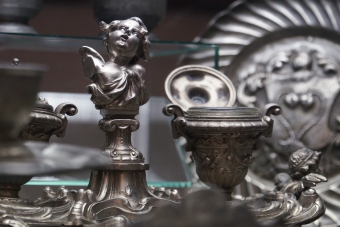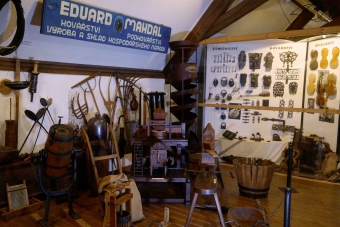Multitopic and thoroughly structured, the exhibition offers to visitors – especially those interested in regional history – an opportunity to learn much about the extinct way of life of the middle classes in Uherský Brod and neighbouring villages between the 17th and 20th century.
The exhibition is divided into two parts – historical and ethnographic, which are mutually linked and provide a comprehensive view of everyday life of different social strata in the region of Moravian Slovakia in the past.


The exhibition follows on from an earlier one, the Jubilee Exhibition – 100 Years of the Museum of Uherský Brod, which was opened to visitors between 1998 and 2001. It shows a selection of most interesting exhibits that that J. A. Comenius Museum has accumulated in its collections over more than hundred years of its existence. The design of this standing exhibition had been developed by Alexandra Zpurná and Jan Gazdík; preparatory works were carried out between 2001 and 2002.
Historical Collections
Some of the oldest exhibits on display come from historical collections of artefacts related to the town of Uherský Brod. It is, above all, a carved wooden statue of Černý Janek (Black Johnny) and a fraction of a wrought iron grille from 1737 decorated with the town crest and with lilies. Read more
Militaria
The oldest artefacts, which date back to the 18th century, are an oriental scimitar, hatchets, and sabres, which had been colelcted by a native of Uherský brod, Alois Schweiger, during his journeys around the world and later donated to the Museum together with a fencing hood and an epée from the 19th century. Read more
Pewter
Pewter objects that can bee seen at the exhibition are for the most part commonly used tankards, dishes etc. used for dining, i.e. objects of everyday use from the 18th and 19th centuries, acquired through donation or purchase.
From a historical point of view, the most valuable pewter is that obtained from the Obora Chateau, from the estate of JUDr. Wenzel Count von Kaunitz. Dating back to 1733, they belong to the oldest exhibits. Read more
Burgher Household

Burghers’ life of the 19th and 20th centuries, specifically the actual life of burghers in the town of Uherský Brod, is illustrated by a collection of artefacts coming from urban households and by a middle-class drawing room dating from the same period.
A drawing room (or parlour), which is part of the exhibition, was an integral part of 19th-century middle-class households. As a rule, it was the most spacious room of the entire apartment, which was closed for the family for most of the time and was used only a few times a year on special family occasions, such as baptisms, weddings, or receiving important guests. Read more
Guilds of Uherský Brod
A large set of exhibits is connected with work and livelihood of the middle classes of Uherský Brod, town and guilds, crafts, and commerce. Here, the visitor can see examples of finished and semi-finished products manufactured by small craftsmen, as well as local traders′ shop signs and advertising boards. The main crafts represented by the exhibits are dyeing, way chandlery, locksmith trade, violin making, watch making, clock making, and stove making.
Objects of technical interest
The whole historical part of the exhibition is supplemented by interesting technical devices, such as musical instruments (polyphon, chordephone), unusual typewriters, the first projection device used in Uherský Brod, a surveying theodolite etc., and by examples of aristocratic furniture from the 18th and 19th centuries most of which was bequeathed by the family of the counts of Nostitz, including Baroque paintings by the Dutch painter Hamilton and by J. Klír, a personal friend and portraitist of the aforesaid noble family.
Museum′s Ethnographic Collections
This section not only illustrates the now-extinct way of life of the rural population in Moravian Slovakia, but also depicts feast-day and everyday activities associated with the then entertainment, agriculture, and village craftsmanship. Read more



